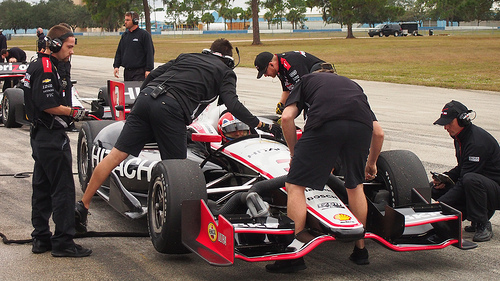By: Daniel Kim
Featured Image – “How much did the R&D cost behind this piece of carbon fiber?” by ph-stop licensed by CC 2.0
By comparing the front wing designs of Indy cars and F1 cars, hopefully you guys will get to learn something about aerodynamics and the budget differences between the two open-wheel series.
What’s the point of a front wing?
The front wing (the big shovel-looking thing at the front-most part of the car) is the most important piece of aerodynamic equipment on a racing car. It provides downforce and sets up the airflow for the rest of the vehicle. When you think about a car just going forward in a straight line, it’s cutting through the air, right? Of course air is invisible so we don’t actually see it, but you imagine what happens to the air as it hits that big shovel in the front of the car. It can’t go through the front wing, so it has to follow it’s curvature, then go wherever the curvature takes it.
If the racing car is traveling very fast, a lot of air is hitting that front wing. As it hits the front wing and flows up and over the car, it creates downforce, which is a force that pushes the car down onto the track. This is important because we need that downward force to keep the car glued to the track so it can turn better.
What happens to the air after it hits the front wing?

By: Jake Archibald
The biggest trouble point for aerodynamicists who work on race cars is the wheels. They can shape the bodywork of a car beautifully and to be extremely slippery, but there’s nothing they can really do about the wheels. So if we look again at the front wing and we can imagine air following the path of the curvature of the wing, where does it go after that? Well, connecting the dots, it looks like the slope of the wing leads the air right up over the front wheels. This is an effect purposely created by the aerodynamicists, who want to avoid any air getting into that turbulent section near the wheels. Ideally, they want the smoothest airflow possible all-around every surface of the car.
A good front wing design will not only provide good airflow at the front of the car, but will make the air travel to the certain places at the middle and rear of the car that the aerodynamicist wants, to provide downforce at the rear and cooling in the necessary places.
Complexity of F1 front wings

By: Jitesh Jagadish
If we look at an F1 front wing, it is very complex. Nowadays, some have 9+ ‘elements’ (an element is basically a fancy name for each part or ‘thingy’ attached to the wing). In this photo of four spare front wings for the Williams F1 team, I count about 6 elements. Each wing has two extra ‘steps’ known as flaps (the white parts with the at&t and globe logos), and 4 ‘winglets’ (the little black pieces that look like miniature front wings).
All these pieces don’t end up there by chance. Each has a specific purpose, and has to be researched, designed and tested – which of course isn’t cheap. It’s like performing a high school lab course over and over and over except with a much more complex experiment.
IndyCar vs. F1 front wings: A big difference in budgets

By: Nathaniel Steele
If you look at an IndyCar’s front wing, it looks relatively simple compared to that of an F1 car. I’m fairly certain all the teams in IndyCar use the same bodywork – they purchase it from one specific company. Compare that to F1, where each team must build every single component on their car, and are free to develop them however they wish as long as it meets a certain set of criteria/dimensions.
So to gain a competitive edge, F1 teams spend huge sums of money researching and developing the best front wing possible. It’s just one part of many, but it’s a crucial part, so a lot of $$$ is going to go into that. IndyCar team’s budgets are nothing to scoff at, but nothing compared to the mind-boggling numbers in F1. We’re talking hundreds of millions of dollars per season for F1 teams.
Not to disparage IndyCar at all, but in comparison to Formula 1, it’s relatively simple. And in that way, I feel like it’s more pure – kind of like how some basketball fans prefer college to the pros.


